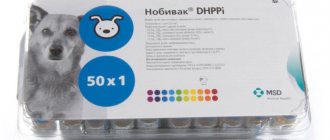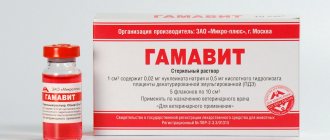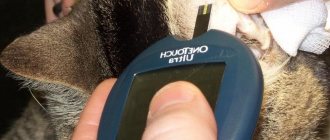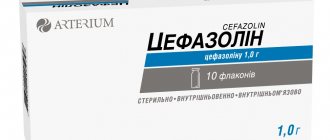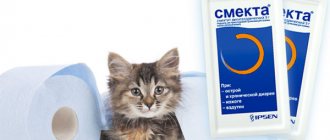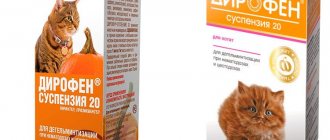Characteristics of the drug Heptral
Heptral belongs to the group of hepatoprotectors, that is, drugs intended to restore liver function. The drug also has an antidepressant effect. The medication promotes the excretion of bile, preventing stagnation. Eliminates the harmful effects of toxins by neutralizing them. The medicine is able to regenerate damaged liver cells, due to which its structure is restored. In addition, the body has an antioxidant effect, which improves the pet’s condition and makes it more active.
Heptral restores the functional activity of liver cells
The drug prevents fibrosis processes in liver tissue and also prevents damage to neurons. Due to the complex effect, the pet’s body quickly recovers from various diseases of the biliary system. In addition, the condition of the coat and skin improves.
The medication is effective even in cases of serious liver problems in pets. It helps eliminate pain and improve digestion.
Composition and release form
The medicine is available in the form of tablets and lyophilisate. The active component for both varieties is ademetionine 1,4-butane disulfonate. Additionally, the tablets include:
- colloidal silicon dioxide;
- microcrystalline cellulose;
- sodium carboxymethyl starch (type A);
- magnesium stearate.
The lyophilisate also contains:
- L-lysine;
- sodium hydroxide;
- d/i water
Heptral is also available in the form of a lyophilisate
The active component is excreted through the kidneys along with urine, which should be taken into account before starting treatment if the pet suffers from severe damage to the urinary system.
How does heptral affect the cat's body?
Heptral affects all cells of the cat's body, but especially liver cells. Through three chemical processes in the liver, SAMe is converted into very important compounds:
Through a process called transsulfuration, ademetionine is converted into glutathione, a powerful antioxidant. Glutathione plays an important role in protecting feline hepatocytes (liver cells) from damage by waste products that the liver removes from the bloodstream and removes toxins from the body (reduces toxic properties). Other cells in the body, such as red blood cells (RBCs), are also protected by this substance. Transsulfuration also produces taurine and other compounds that help in removing bile acids from the liver.
Through transmethylation, heptral helps stabilize cell membranes and promotes bile secretion in domestic cats.
Thanks to aminopropylation, the active substance heptral is converted into other antioxidants and methylthioadenosine, which has anti-inflammatory and analgesic properties in the body of cats.
These three processes, which are discussed in this article, help maintain the structure and function of the feline liver, and also play important roles in nutritional and energy pathways, cell replication, and protein synthesis (the formation of complex proteins from simpler proteins and/or amino acids).
When is the drug prescribed to cats?
The medication is prescribed to pets most often for inflammatory diseases of the liver and gall bladder, such as hepatitis and cholecystitis. This product prevents the formation of stones. The medicine is also effective for congestion in the gallbladder, which can be caused by improper feeding or congenital abnormalities of organ development. The drug is used for malignant tumors and fatty liver. This remedy can be used for a number of viral diseases.
Heptral helps cats recover faster from a number of liver diseases
The medication improves the condition of the liver in cases of severe impairment of its functions, restoring the integrity of damaged cells.
Is it equally beneficial for other organs besides the liver?
Some researchers believe that heptral may be useful in other pathologies associated with damage to cell membranes. Such pathologies may include:
- Diabetes
- Cushing's disease
- Pancreatitis
- Inflammatory bowel disease
- Certain anemias
- Autoimmune disorders
- Certain heart diseases
The effectiveness of Heptral in these conditions has not been determined through controlled studies.
Required dosage and drug interactions
The dosage of tablets and solution depends on the weight of the animal. However, the exact amount of the drug should be discussed with your doctor. If the cat has a body weight of up to 2 kg, then the daily dosage should be about two tablets, which should be given in 2 divided doses. The amount of solution in this case is 0.3 - 0.5 ml.
If the pet weighs from 2 to 3 kg, then the dosage should be 3 tablets per day. The amount of solution for such animals varies from 0.5 to 0.7 ml. For a large cat (5 kg or more) 4 tablets per day are provided. The solution should be used in a dose of 0.9 ml. The course of treatment varies from several weeks to 1 month.
The tablets can be mixed with food or given to the cat by force after first crushing and dissolving with a small amount of water. This can be done either using a miniature syringe without a needle or using a teaspoon. The main thing is to hold the pet properly so that it does not break free and the medicine does not accidentally spill.
It is most convenient to use insulin syringes without a needle to give your pet a pill.
An ampoule with a solvent must first be poured into the lyophilisate. Then shake and apply intramuscularly. In this case, it is most convenient to make the injection in the thigh area. To do this, you need to first feel the muscle; it should roll under your finger. Then insert the needle 1 cm at a right angle and very slowly press on the syringe plunger. It is not necessary to disinfect the injection site.
The easiest way to inject a cat in the thigh is
When treating with Heptral, it is advisable not to give your pet any more medications unless the doctor recommends otherwise. The drug does not combine well with plant extracts and hormonal agents, including glucocorticosteroids.
Attention! It is not recommended to choose the form of the drug yourself. What to use in a particular case: lyophilisate or tablets, only the doctor decides.
How to give an injection to a cat and avoid mistakes - video
How should Heptral be stored?
SAMe is not a stable compound and is adversely affected by moisture and other environmental conditions. This is one of the reasons why it cannot be included in pet food. Drugs should be stored at room temperature in a child-proof container and out of the reach of children and pets. It should be protected from moisture and humidity (for example, do not store in the bathroom). If the tablet comes in a foil package, do not open it or remove the tablet until you use it.
Cautions and Adverse Reactions
The drug has virtually no contraindications, however, if your pet has genetic diseases, then it should be used for treatment with caution. You should not give tablets or inject lyophilisate into an animal if you are intolerant to the active component. The medicine is contraindicated for pregnant and lactating females. Therapy for kittens can only be carried out with the permission of a doctor. The medication can provoke the appearance of such undesirable reactions from the cat’s body, such as:
- nausea and vomiting;
- stomach ache;
- diarrhea;
- digestive disorders;
- dry mouth;
- increased gas formation;
- hepatic colic;
- bleeding from the gastrointestinal tract;
- convulsive conditions;
- joint pain;
- loss of sensation in the limbs;
- sleep disorders;
- difficulty urinating;
- skin rashes and itching.
Sometimes during treatment with Heptral there is a lack of activity in the pet
In rare cases, when treated with tablets and lyophilisate, serious allergic reactions occur, causing swelling of the larynx.
An inflammatory focus may form at the injection site, and in some cases tissue necrosis develops. Occasionally, the drug causes a loss of strength and an increase in body temperature in pets. At the same time, the animal loses its appetite and its condition becomes unsatisfactory. In this case, you need to urgently inform your veterinarian about such undesirable reactions.
A friend has a cat who is overweight. After another study, abnormalities in liver function were revealed, which was due to the presence of extra pounds. The veterinarian recommended a set of medications, including a hepatoprotector. Giving tablets was very inconvenient, since the cat recognized them in the food and refused to eat. A friend crushed the drug and mixed it with water, then injected it with a syringe. Somehow I managed to endure the course of treatment. The liver condition returned to normal, and the cat became more active.
What is the connection between heptral and liver function?
Normally, the liver produces the same from the amino acid methionine, which is present in animal feed. If the liver is damaged, less ademetionine is produced and therefore less glutathione. The less of this antioxidant, the more liver cells are damaged, and a vicious cycle begins.
By giving cats with liver dysfunction "pre-made" the same biological substance in the form of heptral, the liver can produce more glutathione and protect itself from further damage. Increased concentrations of glutathione may also aid in cellular healing and repair in a sick cat.
Even though SAMe is made from methionine, it is not beneficial to give an animal with liver damage additional doses of methionine; it can actually be harmful.
Heptral is recommended for cats with various forms of liver disease
, including hepatic lipidosis (fatty liver), cirrhosis, leptospirosis, toxicity from acetaminophen (Tylenol, paracetamol) and other nonsteroidal anti-inflammatory drugs (NSAIDS), liver fibrosis, cholangiohepatitis, and certain breed liver diseases. It may also be useful for pets receiving long-term treatment for conditions such as epilepsy, in which the drug used is metabolized by the liver.
Precautionary measures
What you need to consider when treating a cat with lyophilisate and tablets:
- Do not under any circumstances exceed the dosage of the drug. In addition, it should be remembered that the amount of medicine is determined only by the doctor, depending on the pathology of the liver and biliary tract. The dosages indicated are approximate.
- Do not inject quickly, otherwise intense pain will occur in the muscle. It is also not recommended to inject with a long needle, which can injure the nerve endings.
- Do not use the same syringe for injections and always wear gloves before starting the procedure.
- Always secure your pet properly. The most convenient way to do this is with the help of another person. This is especially important when administering an injection, since if the cat resists, the needle may enter a vessel or nerve ending.
- If seizures occur in your pet, treatment should be stopped immediately.
- To prevent a hematoma from forming at the injection site and an inflammatory infiltrate from occurring, it is necessary to inject each limb in turn.
- Without preliminary diagnosis and clarification of the cause of the disease, it is prohibited to give Heptral to animals.
- During treatment, coordination of movements may be impaired in cats, so it is important to provide your pet with peace and keep an eye on him.
- When treating with the drug, it is important to provide the animal with access to boiled water.
- If the cat’s condition worsens during treatment, then it is necessary to cancel the course and contact a veterinarian.
For injections at home, it is best to give preference to short needles
Heptral should be used with caution when treating elderly and weakened animals, as the risk of negative reactions increases.
How is the animal's reaction to heptral administered?
The veterinarian will evaluate your pet's response by looking at changes in appetite, weight, activity level, and mood. Always tell your veterinarian about any changes in your cat's condition. The results of physical examinations, as well as radiography (X-rays) and ultrasound tests, will also help determine the response. Blood tests to monitor liver function will be performed periodically. In some cases, a liver biopsy may be required.
It takes some time (often 1 to 4 months) before improvements can be seen with Heptral therapy. In some cases, your veterinarian may reduce the dose of Heptral once a response is obtained.
What can replace Heptral - table
| Name | Release form | Active ingredient | Indications | Contraindications | Possible adverse reactions | Can it be used for pregnant females? | Price |
| Hepatovet | Suspension |
|
|
| Allergy | With doctor's permission. | From 265 rub. |
| Hepatolux | Suspension |
|
|
|
| Not advisable. | From 315 rub. |
| Gepasafe | Injection |
|
| Intolerance to silymarin and vitamin E. | Allergy | Carefully. | From 185 rub. |
Drugs with similar effects - photo gallery
Hepasafe also has an antioxidant effect Hepatovet improves liver function in cats Hepatolux contains milk thistle extract
Learn about essential drugs in animals
- Instructions for the use of Dirofen in cats. Explore the breadth of the anthelmintic effect of Dirofen for the complex treatment of many parasitic pathologies in cats
- Instructions for use of Vetom in cats. Calculate the optimal dose of the drug for cats. Explore the breadth of Vetom's probiotic effect for the comprehensive treatment of multiple pathologies in cats
- Instructions for using multifel in cats. The optimal dose of the drug for cats. Explore the breadth of the preventive effect of Multifel-4 for the comprehensive fight against multiple infections in cats
- Instructions for use of fosprenil in cats. Explore the breadth of metabolic and immunomodulatory effects of fosprenil for the comprehensive treatment of multiple pathologies in cats
- Instructions for the use of Kotervin in cats. Explore the breadth of the anti-inflammatory, saluretic effect of Cotervin for the complex treatment of many pathologies in cats
- Instructions for use of Cat Bayun in cats. Explore the breadth of sedative effects of Kotbayun for the complex treatment of many pathologies in cats
- Instructions for the use of feliferon in cats. Explore the breadth of the immunomodulatory effect of feliferon for the complex treatment of many pathologies in cats
- Instructions for using stronghold in cats. Explore the breadth of the antiparasitic effect of Stronghold Spot On for cats.
- Instructions for use of Milbemax in cats. Explore the breadth of the antiparasitic effect of Milbemax for the complex treatment of many pathologies in cats
- Information about the drug Gamavit, features of its use are provided, excerpts from the instructions are collected, doses for cats are indicated, indications and contraindications for the use of Gamavit for cats
- Instructions for the use of spirovet in animals. Calculate the optimal dose of the drug in dogs, cats, pigs, cows, sheep, goats. Explore the breadth of the antibacterial effect of Spirovet in veterinary medicine
- Instructions for the use of tiamulin in birds and animals. Calculate the optimal dose of the drug in dogs, cats, pigs, cows, sheep, goats, chickens, turkeys, broilers. Explore the breadth of tiamulin's antibacterial effects in veterinary medicine
- Instructions for use of Sevaxel in animals. Calculate the optimal dose of the drug in dogs, cats, pigs, cows, sheep, goats. Explore the breadth of sevaxel's antibacterial effects in veterinary medicine
- Instructions for the use of thiam-oxy in animals. Calculate the optimal dose of the drug in pigs. Explore the breadth of antibacterial effects of thiam-oxy in veterinary medicine
- Instructions for the use of tetravet in animals. Calculate the optimal dose of the drug in dogs, cats, pigs, cows, sheep, goats. Explore the breadth of tetravet's antibacterial effects in veterinary medicine
- Instructions for the use of TAF 25% in chickens, turkeys and other animals. Calculate the optimal dose of the drug in birds. Explore the breadth of the antibacterial effect of TAF 25% a in veterinary medicine
- Instructions for the use of cefkinome in animals. Calculate the optimal dose of the drug in pigs, cows, sheep, goats, horses, dogs and cats. Explore the breadth of cefkinome's antibacterial effects in veterinary medicine
- Instructions for the use of intramycin in animals. Calculate the optimal dose of the drug in dogs, cats, pigs, cows, sheep, goats. Explore the breadth of intramycin's antibacterial effects in veterinary medicine
- Instructions for the use of inotil in animals. Calculate the optimal dose of the drug in dogs, cats, pigs, cows, sheep, goats. Explore the breadth of inotil's antibacterial effects in veterinary medicine
- Instructions for the use of cobactan in dogs. Calculate the optimal dose of the drug. Explore the breadth of the antibacterial effect of cobactan in cats
- Instructions for the use of coliside in animals. Calculate the optimal dose of the drug in birds, pigs, cows, sheep, goats. Explore the breadth of coliside's antibacterial effects in veterinary medicine
- Instructions for the use of Marbox in animals. Calculate the optimal dose of the drug in dogs, cats, pigs, cows, sheep, goats. Explore the breadth of Marbox's antibacterial effects in veterinary medicine
- Instructions for the use of inosel in animals. Calculate the optimal dose of the drug in dogs, cats, pigs, cows, sheep, goats. Explore the breadth of the antibacterial effect of the drug inosel in veterinary medicine
- Instructions for the use of oxytetra in animals. Calculate the optimal dose of the drug in dogs, cats, pigs, cows, sheep, goats. Explore the breadth of oxytetra's antibacterial effects in veterinary medicine
^Top
Can it be used with other drugs?
There are no special contraindications regarding the interaction of this medication with other medications.
It is necessary to use it with extreme caution in combination with herbal and medicinal formulations containing the substance tryptophan.
In any case, before use, you should discuss all the nuances of treatment with your veterinarian.
She eats a pill herself
Undesirable effects
The use of Heptral for a cat in rare cases can lead to unwanted symptoms in the animal. Most often, pets experience allergic reactions: itching, redness of the skin, Quincke's edema.
In addition, the drug can cause diarrhea and nausea in some cats. The hepatoprotector can provoke an exacerbation of chronic bladder infections. Therefore, animals suffering from bacterial pathologies of the excretory organs are prescribed this medicine in a reduced dosage.
How to calculate dosage
The dosage of the drug is calculated based on the live weight of the cat.
Such calculations should only be carried out by a professional veterinarian.
If the cat weighs 2 kilograms, give him 1 tablet 2 times a day, or inject about 0.3-0.5 milliliters of solution. Animals weighing from 2 to 3 kilograms are prescribed 3 tablets per day or 0.5-0.7 milliliters of solution. If you weigh more, you need to give 4 tablets and about 0.9 milliliters of injection. On average, the course of treatment for a serious illness takes 1 month.
A harmless little prick
Keeps our cat healthy.
Our cat has chronic liver failure and suspected cirrhosis.
This year there were 2 acute attacks in the off-season, they pulled it out with everything they could for a whole month. The answer went to Heptor. We have not tested the drug on ourselves, but I can say with confidence that it helps, the cat is provided with tremendous support, which gives it the opportunity to move on with its life. The tests after it are quite normal for her illness. The drug was prescribed by the veterinarian after a course of other medications, to which the cat did not respond and slowly faded away. She refused food and water and lived on IVs and injections. After Heptor's therapy, improvements began. At first they injected me intravenously, and when she started eating, they started giving her 1/4 tablet once a day. The body started working and life began to return. Now we sit on Heptor all the time, because our health has been neglected by the previous owners, we also adhere to a strict diet, and feed ourselves with Royal Canin VD HEPATIC food.
When taking the pills, we had some minor difficulties, the cat won’t eat them on its own, and neither will any other cat because of the sour taste of the pills, so we had to manage to give them somehow. It is also useless to mix it into food; the taste is very noticeable. Our cat is calm, so I just crushed the tablet and tried to put it on the root of the tongue, then the animal is less likely to spit it out. Despite the fact that the tablet needed to be crushed, the parts still turned out uneven and different in size, it is difficult to give larger ones, but perhaps an overdose is not terrible, you don’t have to worry about it. I crush the tablets with large kitchen scissors, simply clamp and cut off the required amount. The knife crumbles the tablet a lot and then it is impossible to give it, the cat spits and foams. I do not recommend cutting into several parts at once; it is better to cut off gradually. Heptor tends to absorb moisture and becomes sticky at the cut site, so I store it in the refrigerator, where it behaves well. Pet stores sell special devices for dispensing tablets, but we manage without it. At the moment this is our salvation + a strict diet. Most likely for life.
Take care of your pets, feed them properly and love them. And let them not get sick!
The cat is 7 years old. The diagnosis is hepatitis, due to poisoning. We have been treating him for a month now, but the condition is worsening, and our chances of survival are almost zero. I would really like to hear from those who managed to save their pet from this disease: how serious their condition was.
Hello! I recommend going to the Medvet clinic in Moscow to see Dr. Veronika Andreevna Labyntseva, a very good doctor and if there is an opportunity to save your pet, she will make every effort to do so. There are generally a lot of good specialists there, who are pros in their field..
My Sphynx showed the first symptoms of hepatitis, she turned a little yellow, they immediately took her to the vet, the biochemistry test was very bad, they prescribed Heptral intravenously 10 cam 2 times a day, Heptral + 50 ml saline solution + B12 drops 1 time a day, (it’s very important through an IV, the injections are not effective) Gamavit, Kaventaren, Kavertal, injections in the withers 1 time per day, another Karsil 3 months 3 times and Allahol 20 days 2 times, during the IVs and the development of the disease, the cat stopped eating and drinking, fed baby food food and entrusted fish for a meager amount per day, if she didn’t eat, she poured chicken broth by force, now the cat has recovered, everything is fine
Is there a chance the doctor will answer after taking tests and a course of treatment? Go only to trusted clinics (Medvet, Bilants, White Fang)
Hello . An 18-year-old cat was diagnosed with hepatitis (by examination). He has not eaten or drunk anything for 3 days. Please advise what to do. Is there any point in putting him to sleep or waiting for him to go away on his own?
I can advise you to buy baby pate, baby food, it will really help the cat eat
We have been fighting for 23 days. Our cat is 17 years old. I stopped eating, I was vomiting bile, my entire skin turned yellow. He was diagnosed with hepatitis and cholecystitis, they said that the prognosis was extremely unfavorable, there was almost no chance. They prescribed Heptral, Ursofalk, Milgamma, ascorbic acid, droppers with saline solution, Sinulox. Milgamma and ascorbic acid were discontinued and Noshpa, metronidazole, and umbrella were prescribed. Many injections intravenously and intramuscularly, the therapeutic diet Royal Conin Renal and Hepatic. The tests are crazy: bilirubin is 190 when the norm is 10! ALP, ALT, AST - all are many times overestimated! ESR - 40, when the norm is 4! The liver was enlarged by 2 cm. He refused to eat at all, did not drink water, his hind legs were paralyzed, he was vomiting bile, they fed him themselves, putting food in his mouth. But we are alive, our cat is desperately fighting for his life. Now we are piercing the fourth (.) pack of Heptral, we have prescribed Ursofalk and Creon for life, droppers with saline solution every few days. The cat has gained an appetite, he eats little by little, feeds him up to the daily portion, drinks water, stands on his paws, walks, runs, and jumps onto the sofa with ease. As before, he purrs his affectionate songs to us. The yellowness of the skin began to subside. The tests have improved - bilirubin has dropped to 80. We continue treatment and supplementary feeding. We have already spent about 25 thousand. And we will continue to fight the disease.
Hello! We have the same thing((How is the cat’s condition now? PS I wonder which “strange” person downvoted your post. /
I can advise you to buy baby pate, baby food, it will really help the cat eat
“Waiting for him to leave on his own” is something disgusting. You can do a blood test (CBC and biochemistry) and ultrasound. To diagnose. If the cat turned yellow (the veterinarian had reason to diagnose him with a simple examination), IV drips are needed. At least 6-7 pieces. With heptral. And make a decision based on the activities carried out.
As far as I know, droppers with heptral never interfere with other drugs. My veterinarian categorically forbade me to mix anything into the heptral drip. (In your case B12) Allohol is not used for cats. Talks about the vet's qualifications. There is Ursofalk and Silimar (it is more effective than Karsil, I don’t know why)) It’s good that the cat felt better..
Vaseline oil is bad for hepatitis, it is fat.
Vaseline oil is not absorbed into the body of cats. It simply passes along the intestinal walls, helping to remove callas. This is a cat laxative and is not harmful if taken correctly. You also need to pour it in carefully so that it doesn’t get into your respiratory tract! It's the most important!
I have a cat Kefir)) 6 years old. We have been treating hepatitis for two months now (((the jaundice has almost gone away, he has begun to move, the other day he purred for the first time, he began to go into the kitchen to his cups. But he does not eat or drink (((I have been force-feeding from a syringe all this time chicken meat with broth and baby nutrition. I started vomiting on all the medications and food, they increased the amount of antiemetic drugs. The doctors said that dystrophy had begun (((I don’t know what to do. On the one hand there seems to be an improvement, but on the other. He is my son.
Who had what results? Three of me got hepatitis..((((
The next day it didn’t get any better, after lunch we went again, a different doctor, didn’t examine me, didn’t ask, just on the list of IVs again. They had already finished the dripping, were getting ready to go home, she urinated on herself... with blood... My horror knew no bounds! I say what is this?! First he said: how do I know, and then that this is inflammation of the bladder, because according to the tests it doesn’t look like kidneys. He also prescribed an antibiotic and gave me one injection right away. We came home, she ate a little, I thought there was improvement, but I was wrong... At night, she came to me and sat and watched for a very long time, it was she who said goodbye. ((((((((((We are on our 3rd visit, the last time for IV drips, at first everything was stable, when they gave her glucose, she started to tremble, they said it was normal, then white foam started coming out of her mouth, and she started vomiting bile. I said to turn off the drip, and realized that I needed to go to another hospital. It was March 7, most were not working, I found one, examined it normally, they said the liver was very enlarged, they needed an ultrasound urgently, to rule out cancer, too. Those **** * they didn’t even send it. They did an ultrasound, then I noticed for the first time that she had turned yellow. They said there was no cancer, but the liver was all over her stomach.. and that treatment didn’t suit her at all. We just wasted time and tormented her. And I still held on( ((I wanted the best, I can’t forgive myself. If I had immediately gone to another clinic, there would have been a chance! She was exhausted and healed! I left her for 4 hours, they said they would call me when to take her home, but then they called and said that she had died "My grief knew no bounds. I buried her on March 8. The diagnosis was chronic sluggish hepatitis with acute exacerbation.
"Heptral" in tablets or injections: which is better?
"Heptral" is available in two classic form factors: tablet and liquid form. For cats, an injection solution is almost always used, which is injected intramuscularly (possibly at home) or intravenously (through a catheter, only in the clinic).
Despite the fact that it is easier to give a tablet to an animal, the injections act more quickly and effectively, and do not put a strain on other organs, since they do not enter the cat’s gastrointestinal tract. Treatment with the drug in tablet form is prescribed only when the owner does not have the opportunity to give the animal injections himself or take it to the veterinary clinic.
"Heptral" is produced in tablets and lyophilisate for preparing a solution
"Heptral": side effects, contraindications
When using Heptral, cats rarely experience negative body reactions, but the owner must be prepared for the fact that both tablets and injections can provoke allergies in the pet (itching, swelling, skin reactions), restless behavior, stomach upsets, and vomiting. It is not permissible to take the drug to animals whose biochemical blood test showed a deficiency of vitamin B12; Heptral is also not prescribed to pregnant cats.
As for the interaction of Heptral with other drugs, there are no special contraindications. Caution should be used when combining a hepatoprotector with herbs and medications that contain tryptophan. Therefore, it is imperative to discuss with your veterinarian not only the current prescriptions, but also the advisability of taking other medications if they were previously prescribed to the animal.
The progress of treatment with Heptral should be monitored daily by a veterinarian
